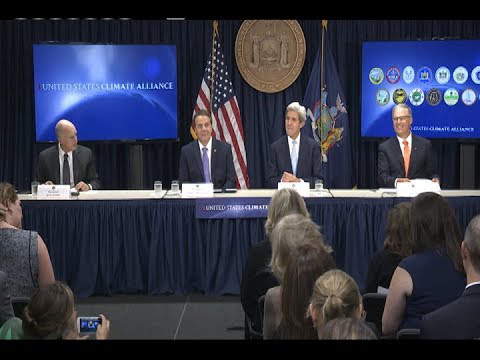

By Luis Martinez and Kit Kennedy
In a forceful show of climate leadership, Governors Andrew Cuomo (NY), Jerry Brown (CA), and Jay Inslee (WA) and former Secretary of State John Kerry came together in New York City Wednesday as part of Climate Week to celebrate the progress and growth of the U.S. Climate Alliance, the bipartisan coalition that has grown to 14 states dedicated to meeting the Paris agreement climate goal. The coalition was founded by Cuomo, Brown and Inslee after President Trump announced the U.S. intent to withdraw from Paris.
President Trump may prefer to pretend that climate change isn’t real—Gov. Cuomo quipped that the Trump administration is in “the State of Denial”—but these leaders detailed the extraordinary strides they’re making, in the absence of White House leadership, to slash greenhouse gas emissions and grow their economies at the same time. For New Yorkers, it’s exciting to see Cuomo’s leadership on clean energy and climate continue to accelerate, from setting strong renewable energy goals, to a successful push with other Regional Greenhouse Gas Initiative states to further slash carbon emissions, to banning fracking.
It was a privilege to attend Wednesday’s event, where the governors announced that North Carolina has joined the alliance. North Carolina Gov. Roy Cooper said in a statement that “[i]n the absence of leadership from Washington, North Carolina is proud to join the U.S. Climate Alliance, and we remain committed to reducing pollution and protecting our environment.” North Carolina has risen to No. 2 nationally for installed solar capacity and is home to more than 34,000 clean energy jobs. And Gov. Cooper recently signed legislation that is expected to roughly double North Carolina’s solar generation over the next four years. Kudos to Cooper for joining the alliance and ensuring that North Carolina remains at the forefront of the clean energy economy.
Other members of the coalition are Colorado, Connecticut, Delaware, Hawaii, Massachusetts, Minnesota, Oregon, Rhode Island, Vermont, Virginia and the Commonwealth of Puerto Rico. And we’re counting on that list to grow even more!
Bright Statistics
According to a new report issued by the alliance Wednesday the coalition represents 36 percent of the U.S. population; 40 percent of U.S. gross domestic product; at least $7 trillion of combined economic activity and 13 million clean energy jobs. These states are proving that climate leadership promotes economic growth:
- U.S. Climate Alliance states are on track to reach a 24 to 29 percent reduction in greenhouse gas emissions from 2005 levels by 2025, helping to achieve the Paris agreement targets that scientists say are necessary to try to keep the increase in global warming to 2 degrees Celsius and stave off the worst effects of climate change.
- Between 2005 and 2015, alliance states reduced greenhouse gas emissions by 15 percent compared to a 10 percent reduction by the rest of the country.
- During that same decade, the combined economic output of alliance states grew by 14 percent while the rest of the country grew by 12 percent. On a per capita basis, economic output in alliance states expanded twice as fast as in the rest of the country, showing that climate action and economic growth go hand in hand.
- The alliance states have attracted nearly $100 billion in renewable energy investment since 2011.
Alliance members’ progress and the growth in their ranks is welcome news. With the Trump administration more interested in propping up its friends in the fossil fuel industry than confronting the existential threat of a warming planet, their leadership is crucial.
The Natural Resources Defense Council (NRDC) stands ready to help these states and others in achieving their climate and clean energy goals. In our new report, America’s Clean Energy Future: The Pathway to a Safer Climate Future, based on comprehensive modeling performed by internationally recognized consultants E3, we show that the U.S. can slash climate pollution by 80 percent by 2050 primarily by going big and fast on three key strategies: scaling up energy efficiency improvements to cut overall energy demand in half; scaling up renewable energy to provide 80 percent of our power; and electrifying vehicles and key building energy uses. Underlying these key strategies, we need to build a stronger, smarter, more resilient electricity grid. We can do all this at a cost of only 1 percent of annual energy costs—and by 2050 our pathway costs less than “business as usual.”
Governors Cuomo, Inslee, Brown, Cooper and the other U.S. Climate Alliance governors are showing us what climate leadership looks like. Like NRDC, they’re galvanized by the Trump administration’s abject failure on climate and are ready to keep pushing forward. We know the clean energy pathway to meeting our U.S. climate goals—let’s get going on our own. There’s so much more to do and states and cities can lead the way until the federal government is ready to lead again.

 233k
233k  41k
41k  Subscribe
Subscribe 